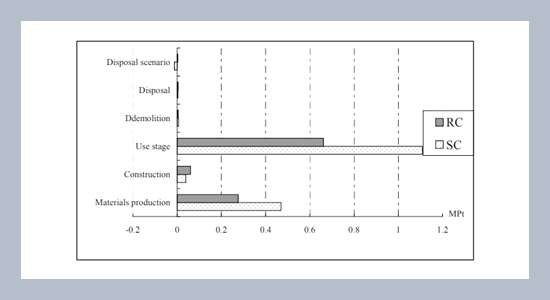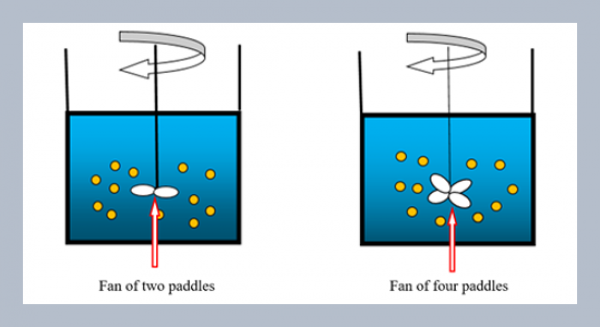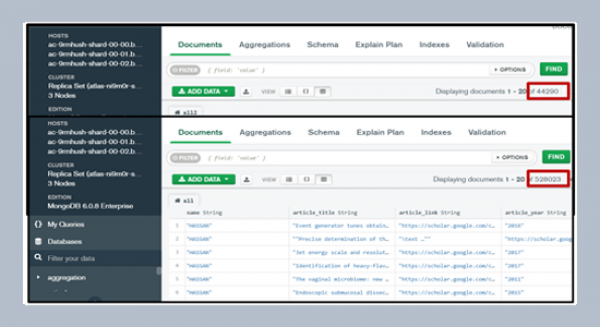Sheng-Lung Lin* and Yu-Feng Wei Department of Environmental Engineering and Management, Chaoyang University of Technology, Wufong, Taichung County 41349, Taiwan, R.O.C.
Download Citation:
|
Download PDF
The incorporation of environmental and energy considerations into the building design will become the main stream of the construction industry. This paper intended to demonstrate the life-cycle assessment method employed in the analysis of energy consumptions and environmental impacts during the life time of the school buildings in Taiwan. There are two popular types of school buildings in Taiwan nowadays. One is steel-based construction (hereafter referred to SC). The other is reinforced concrete construction (hereafter referred to RC). Two selected buildings located at Taichung County have been analyzed in the study. Five stages were identified in the whole life of school buildings including material production, erection, occupation, demolition, and disposal/recycling scenario. A 50-year service time was assumed for both buildings. The results show that the most energy consumption occurs in the occupation stage for both selected school buildings. They contribute 95.8% and 87.2% of the total energy consumption in its service time for the SC and RC buildings, respectively. However, the construction processes may influence the energy consumption significantly. It also concluded that both selected buildings consumed lots of energy during the first 30 years, and then energy consumptions of the selected school buildings was leveled off. The inventory data was simulated in an LCA model and the environmental impacts for each stage were indicated as numerical scores based on the Eco-indicator 99.ABSTRACT
Keywords:
Environmental and Energy Considerations in Two Selected SC and RC School Buildings in Taiwan
Share this article with your colleagues
[1] Adalberth, K. 1997. Energy use during the life cycle of buildings: a method. Building and Environment, 32: 317-329.REFERENCES
[2] Khanduri, A. C., C. Bedard, and S. Alkass. 1996. Assessing office building life cycle costs at preliminary design stage. Structural Engineering Review, 8: 105-114.
[3] Kua, H. W. and S. E. Lee. 2002. Demonstration intelligent building—a methodology for the promotion of total sustainability in the built environment. Building and Environment, 37: 231-240.
[4] Peuportier, B. L. P. 2001. Life cycle assessment applied to the comparative evaluation of single family houses in the French context. Energy and Buildings, 33: 443-450.
[5] Cole, R. J. and P. C. Kernan. 1996. Life cycle energy use in office buildings. Building and Environment, 31: 307-317.
[6] Federspiel, C., Q. Zhang, and E. Arens. 2002. Model-based benchmarking with application to laboratory buildings. Energy and Buildings, 34: 203-214.
[7] Filippin, C. 2000. Benchmarking the energy efficiency and greenhouse gases elected SC and RC emissions of school buildings in central Argentina. Building and Environment, 35: 407-414.
[8] Ameziane, F. 2000. An information system for building production management. International Journal of Production Economics, 64: 345-358.
[9] Jonsson, A., T. Bjoklund, and A. Tillman. 1998. LCA of concrete and steel building frames. International Journal of Life Cycle Assessment, 3: 216-224.
[10] Gunther, A. and H-C Langowski. 1997. Life cycle assessment study on resilient floor coverings. International Journal of Life Cycle Assessment, 2: 73-80.
[11] Zmeureanu, R. and C. Peragine. 1999. Evaluation of interactions between lighting and HVAC systems in a large commercial building. Energy Conversion & Management, 40: 1229-1236.
[12] Rabie, N. and G. J. Delport. 2002. Energy management in a telecommunications environment with specific reference to HVAC. Building and Environment, 37: 333-338.
[13] Jenning, A. A. 1995. Automating probabilistic environmental decision analysis. Environmental Software, 10: 251-262.
ARTICLE INFORMATION
Accepted:
2005-03-23
Available Online:
2005-04-03
Lin, S.-L., We, Y.-F., 2005. Environmental and energy considerations in two selected SC and RC School Buildings in Taiwan. International Journal of Applied Science and Engineering, 3, 69–79. https://doi.org/10.6703/IJASE.2005.3(1).69
Cite this article:















